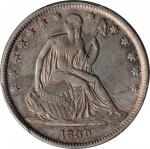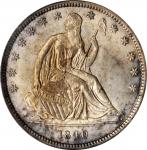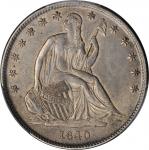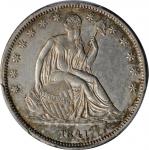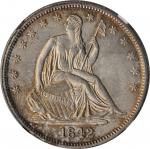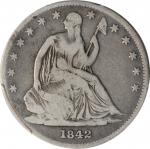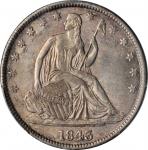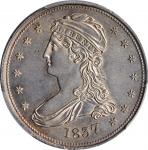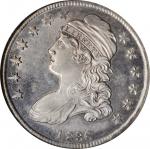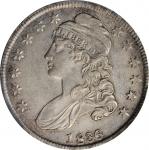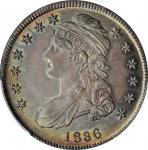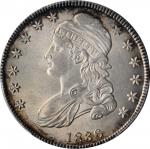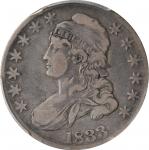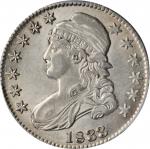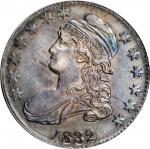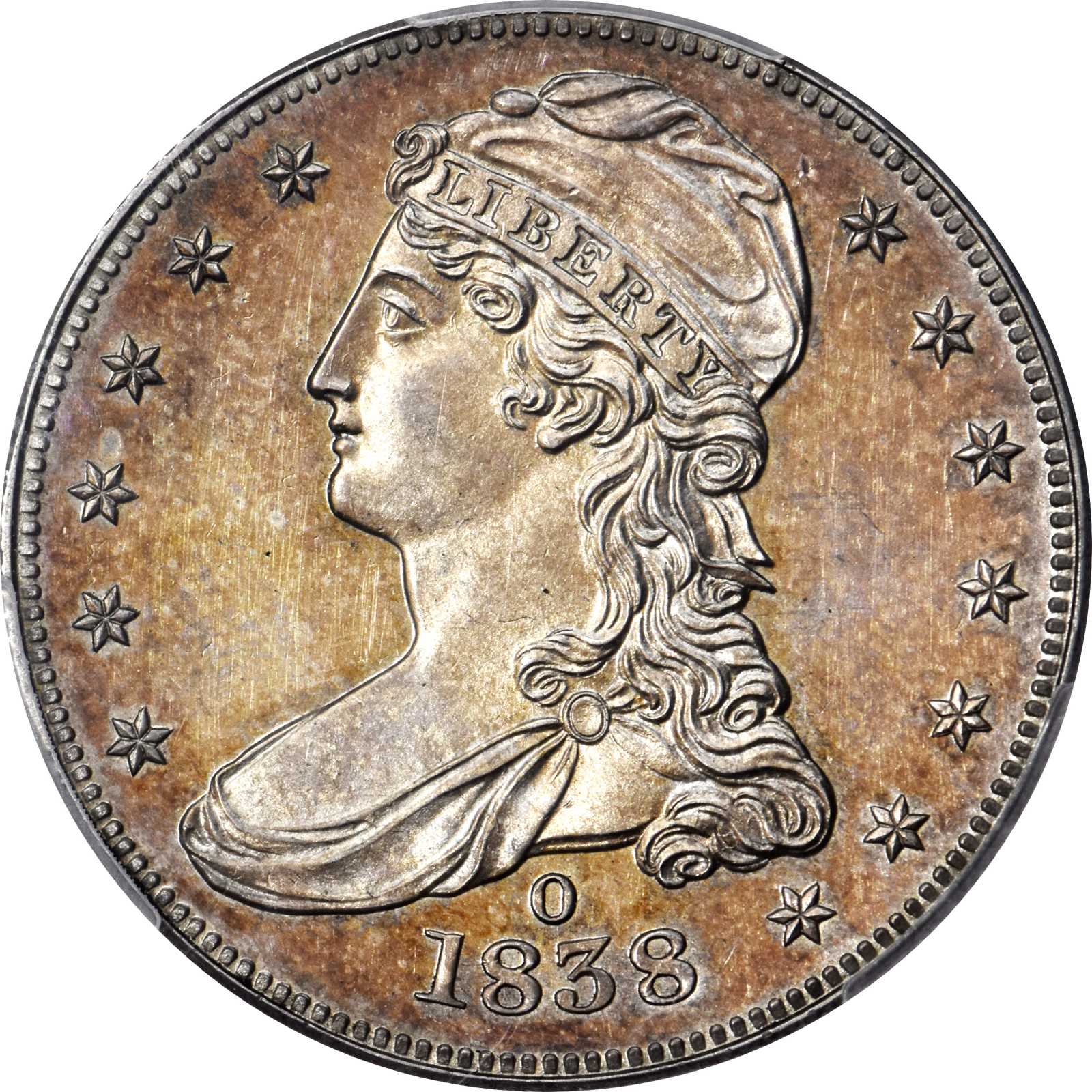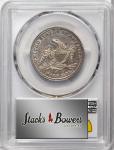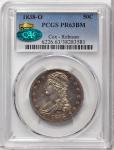1838-O Capped Bust Half Dollar. Reeded Edge. HALF DOL. GR-1. Rarity-7. Specimen-63 (PCGS). CAC.The 1838-O is one the most famous rarities in all of numismatics, a truly legendary coin loved for its enigmatic history, sheer beauty and New Orleans Mint origin. Few coins can achieve the status of an American numismatic classic to the degree of the 1838-O half dollar, a coin that has more than earned its place as number 19 in the popular reference <em>100 Greatest U.S. Coins</em> by Jeff Garrett and Ron Guth. A mere 20 examples are thought to have been struck, nine of which have been confirmed to survive to date. The story of its genesis coincides with that of the New Orleans Mint, the first branch mint to strike silver coinage, and it is reprinted here from our recent (May 2016) offering of the Proof-64 specimen in the D. Brent Pogue Collection:<p>On March 3, 1835, Congress appropriated $200,000 for the construction of a mint at New Orleans, Louisiana "for the coinage of gold and silver." The act also authorized $50,000 each for construction of mints at Charlotte, North Carolina and Dahlonega, Georgia, facilities that would be authorized to coin only gold. In Section 4 of the act, the mints were placed "under the control and regulation of the director of the Mint at Philadelphia," who would be responsible for ensuring there was a method of "discriminating the coin which shall be stamped at each branch" while also "preserving uniformity of weight, form, and fineness in the coins stamped at each place." Letters were chosen to represent each of the branch mints, to be placed conspicuously on each coin. Unlike France, which made the mother mint in Paris "A" while other mints were represented with B, C, and others in sequence, the branch mints of the United States would be known by letters that abbreviated the name of their city. The coinage of the branch mint in New Orleans was to be marked O.<p>The first coins struck with an O mintmark were dimes, coined in May 1838. While dimes were useful for local small change, half dollars were the largest and most important silver coins then in common circulation. Enormous quantities of foreign silver coins were imported into the United States via New Orleans, mostly from Mexico and the West Indies. Only full scale production of large denomination silver coins like half dollars could efficiently convert the flow of uneven quality Latin American silver coins into a sufficient quantity of new United States coins fit for banking and commerce. Thus, half dollar coinage became a primary goal of the New Orleans facility.<p>As with so many grand plans, the beginnings of the New Orleans Mint were problematic. With a fine new structure, and a fresh allotment of dies sent from the mother mint in Philadelphia in separate packages on April 9 and April 11, the technical footings were set for success from the day the mint opened. Twelve dies were received in the mail from Philadelphia on May 3, representing two pairs of dies for half dimes, dimes, and half dollars. Dimes were put into production first, with a run of 30 pieces on May 8. These dimes were mostly reserved for presentation, including one mailed to Philadelphia Mint Director Robert M. Patterson on May 12. The small press used to make dimes encountered difficulty soon thereafter, forcing an interruption in dime production. Repairs were undertaken, and dime coinage resumed for a short time in early summer, before another calamity hit: yellow fever. The late summer scourge closed the Mints doors for all of August, September, and October 1838. After reopening in November, the first half dimes were struck, a production run that continued after the beginning of the New Year. 1838 had come and gone, and not a single half dollar had been struck.<p>On January 17, 1839, Mint Director Patterson wrote to New Orleans Mint superintendent David Bradford, cautioning "no time should be lost in getting ready for the coinage of half dollars." "Dimes and half dimes count too slowly," Patterson added, "and keep your account of coinage too low." Dime and half dime coinage continued apace in early 1839, as a February 25 letter indicated that "we are averaging more than 25,000 pieces per day," but officials at both Philadelphia and New Orleans recognized that there could be no substitute for half dollar coinage, and it must begin as quickly as possible.<p>The February 25, 1839 letter from Coiner Rufus Tyler to Patterson is the first to mention the coinage of 1838-O half dollars, and it makes clear that the first 10 coins were produced as test strikes. Tyler pointed out that the dies sent the previous year were now "unsuitable for present use, for besides being out of date, the bottom ones are too short to reach the screws and consequently cannot be secured in the seat." The dime press was far too small for half dollars, and the half dollar press was not yet in working order, so Tyler had attempted to mount the half dollar dies in the largest press, intended for dollars. Too short to fit in this largest press, the half dollar dies must have resembled children in a full sized chair with their legs not able to touch the ground. Tyler, an ingenious mechanic, remedied this with a temporary solution, affixing a piece on the bottom of the die body to make it rest more comfortably in the press. "I have however spliced one of them in order to try the press and succeeded in making ten excellent impressions; the very first one struck, being as perfect as the dies, and extremely satisfactory, but the piece upon the bottom of the die became loose and I was unable to strike any more without further fixing."<p>Superintendent Bradford followed with a letter two weeks later, on March 7, which more precisely identifies when the first 10 1838-O half dollars were struck. "About the middle of January Mr. Tyler struck a few pieces - half dollars - in the large press [the dollar press]. He informed me that the half dollar dies that had been received at this Branch Mint were made for Mr. Eckfeldts press [the half dollar press] and were too short for the large press." Bradford described Tylers fix, but noted that the "member fitted to supply the length" had been "crushed after striking a few pieces." Bradfords letter went off to Philadelphia in the mail, and as it went north, the new 1839 half dollar dies headed south. Patterson had forwarded two pairs of dies to Secretary of the Treasury Levi Woodbury to send on to New Orleans on March 12, 1839.<p>On March 29, 1839, David Bradford wrote Patterson from New Orleans to let him know that his last two letters "were before me," having apparently just arrived that day, and "the pair of half dollar dies you sent on the 12th have also arrived." Bradfords first body paragraph sounds apologetic, as if covering himself while reporting the directions he gave to coiner Rufus Tyler: "I stated to Mr. Tyler that you advised that the dies of 1838 be not used and I suggested that it would be best to return them to you...but he thought it not worthwhile." Just a few lines later, Bradford reported some good news: "Mr. Tyler has got the half dollar coining press in operation. He commenced striking on the evening of the 27th inst[ant] and the press is now performing admirably." In light of the letters opening, it seems that the first half dollars struck on the half dollar press were struck with the 1838 dies, representing a second batch of 1838-O half dollars in addition to the 10 coins Tyler had coined in January.<p>The historical record then fell silent on the production of the first New Orleans Mint half dollars, a rarity from the moment they were made. 1839-O half dollar production started within days of the last 1838-O halves being coined, and some authorities have suggested that the die state of at least one 1838-O half dollar (the Smithsonian specimen) is actually later than the earliest state seen on the 1839-O halves, most of which were struck with a leftover 1838 reverse die. In 1894, Ed. Frossard offered an 1838-O half dollar with an original transmittal note from Rufus Tyler that filled in more of the story of their production. As recounted by Frossard in <em>The Numismatist</em> in July 1894, the letter read: "The enclosed specimen coin of the United States branch mint at New Orleans is presented to Pres. [Alexander Dallas] Bache by Rufus Tyler, the coiner. It may be proper to state that not more than twenty pieces were struck with the half dollar dies of 1838." The mintage figure of 20 coins that has become commonplace in modern literature comes from this source, but Tyler does not say 20 were coined, rather, he says "not more than twenty." Ten were coined, by Tylers own accounting, in January 1839. A few more were apparently struck in March 1839. The exact number remains unknown.<p>Recent research by Kin Carmody suggests that the specimen presented to Bache by Rufus Tyler may be the only survivor from the initial trial striking on the silver dollar press using Tylers improvised fix, although other researchers point to strike doubling on the reverse of both the Bache (read: Anderson-Dupont) and Empire specimens as evidence for coins struck on the silver dollar press from a die that was held by Tylers "splicing," which device had been "crushed after striking a few pieces." In any event, few coins likely survived from Tylers initial striking period using the silver dollar press. Those coins, part of a trial run in anticipation of regular issue circulation striking coinage, were offered to interested parties, but since there was essentially no numismatic interest in the southern United States during the period in question -- and publication of Augustus Heatons treatise on mintmarks was still more than 50 years in the future in 1839 -- most examples were probably not preserved.<p>Carmody further asserts that the 1838-O half dollars struck later on the half dollar press were made for presentation purposes, and these coins were sent to Mint Director Patterson, perhaps alongside the Assay coins in June of 1839. One of the coins forwarded to Patterson is now part of the National Numismatic Collection in the Smithsonian Institution. Many of the other high grade survivors are also likely from the second striking period on the half dollar press, the coins preserved by Mint and/or other government officials and used in trade for desirable coins when numismatics became more popular in the United States during the second half of the 19th century.<p>The known examples of 1838-O half dollars were published by Walter Breen in his <em>Encyclopedia</em> in 1988 and added up to 11 distinct examples. Later researchers have whittled this list down to nine specimens, accounting for accidental duplication in Breens work. Of the nine known, the present offered piece is known as the Cox Specimen and has been off the market since the 1980s. It hails from "Colonel" E.H.R. Green, who once owned no less than six (!) 1838-O half dollars. From there, it passed through the hands of several prominent collectors and dealers.<p>A visually stunning example with distinctly sharp features, the surfaces are highly reflective and clearly indicative of a special striking. Light golden-orange peripheries and brief ice blue highlights mark the obverse, while the reverse displays light copper-rose and pale blue iridescence in the fields. Careful inspection with a loupe reveals a few wispy marks in the obverse field and a tiny oval depression to the left of star 7 above Libertys cap, a useful provenance marker as there are no other obverse marks of any consequence. On the reverse, we note a light die crack through the letters ERIC to the rim above C, a short crack from the bottom of the letter I into the field, and another crack from the left wing tip through the middle set of leaves through the tip of the bottom leaf, the letters HA in HALF and finally ending at the base of letter L. A tiny speck under the left wing and a few more around the arrow heads are also good identifiers. The rims are high and, like the obverse, the striking detail is superb.<p>The 1838-O half dollar as an issue has myriad factors that make it a great numismatic coin, one that will forever be revered, studied and dreamed about. The present coin is a stunning example of the issue, and may well find itself off the market for another 40 years once it sells. The opportunity to acquire such an example may not present itself for some time, so serious collectors should carefully consider and take notice.From the E. Horatio Morgan Collection. Ex "Colonel" E.H.R. Green; Burdette G. Johnson; Wayte Raymond; J.G. Macallister; Charles M. Williams (the likely owner); Numismatic Gallery; Numismatic Gallerys Adolphe Menjou Collection sale, June 1950, lot 1073; Numismatic Gallerys ANA Sale of August 1953, lot 905, per Carl Carlson; our (Stacks) sale of the R.E. Cox, Jr. Collection, April 1962, lot 1873; Empire Coin Co. (Q. David Bowers and James Ruddy); Hazen B. Hinman; Paramounts sale of the Century Collection, April 1965, lot 1151; unknown intermediary; Bowers and Ruddy Galleries (Rare Coin Review numbers 17 and 18); our (Stacks) sale of the Ellis H. Robison Collection, February 1982, lot 1605; Marvin Browder; David W. Akers.





